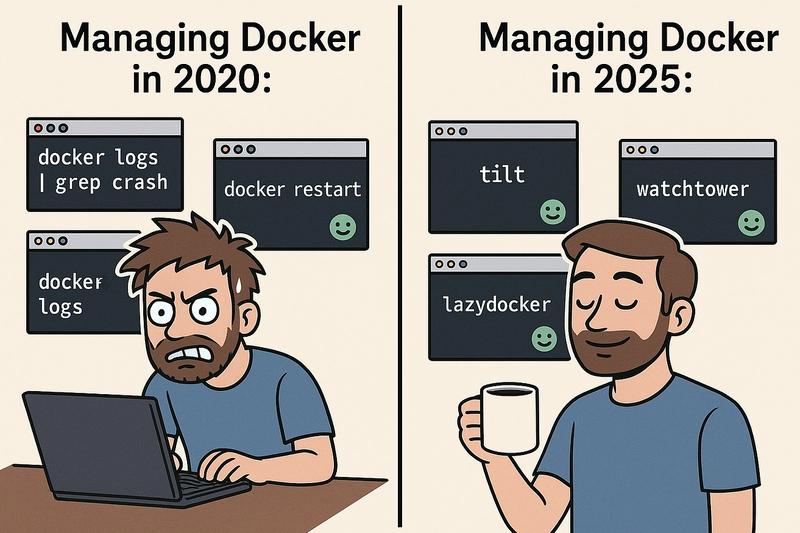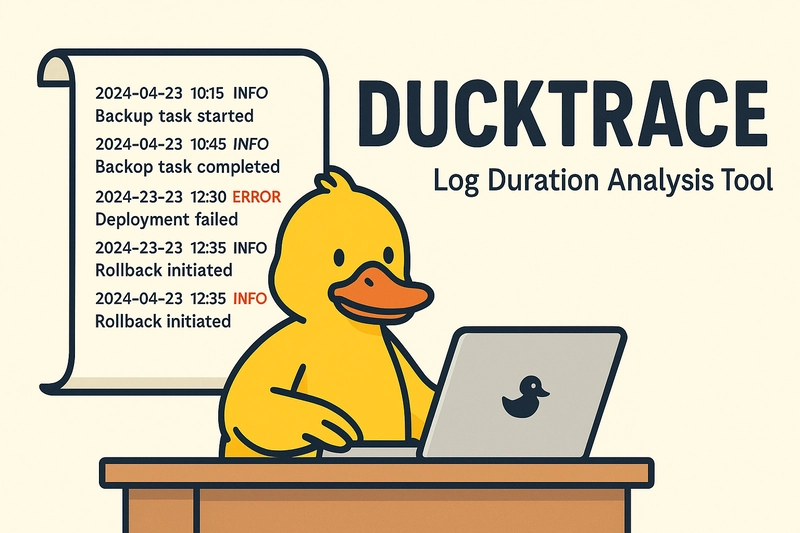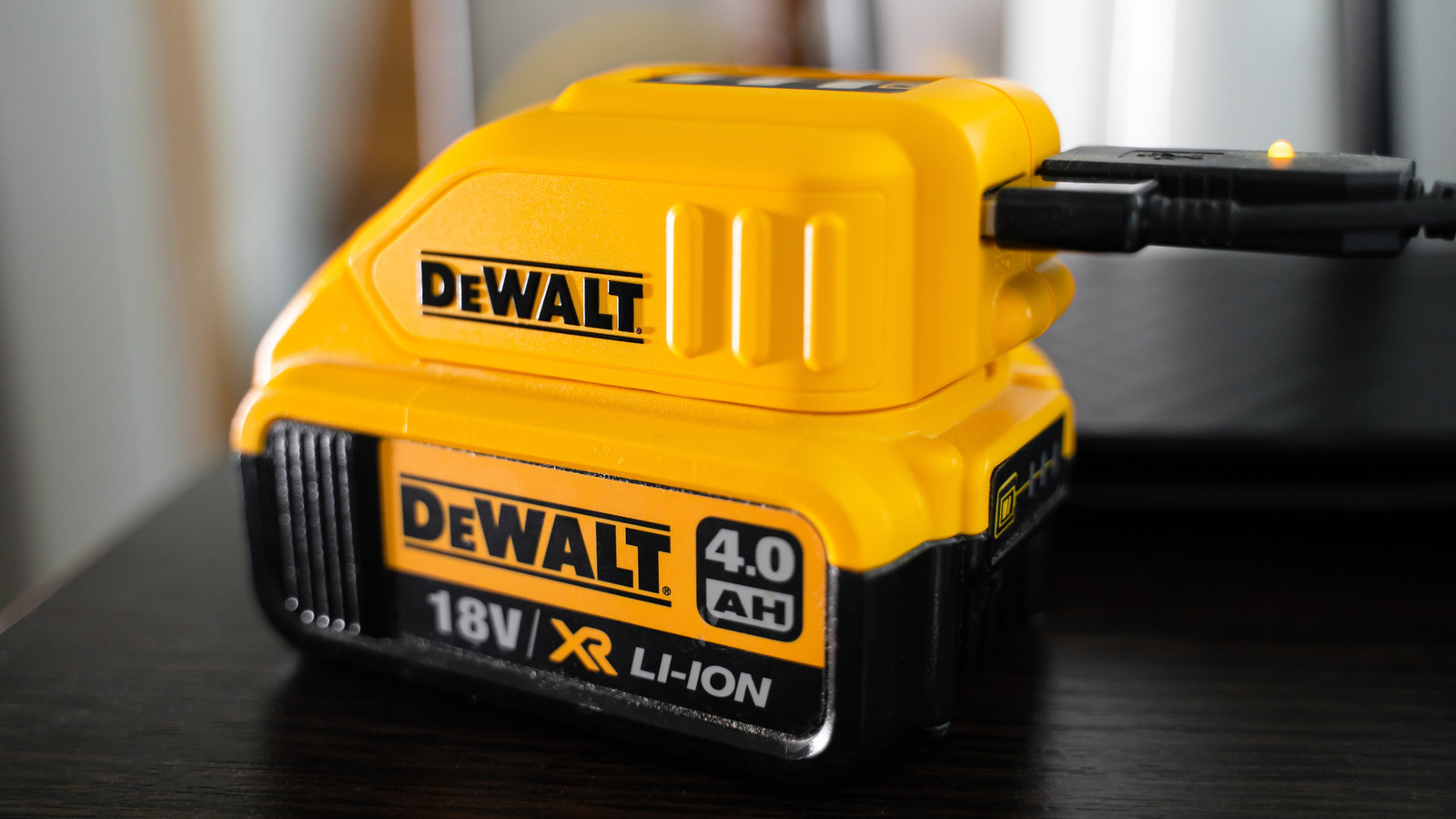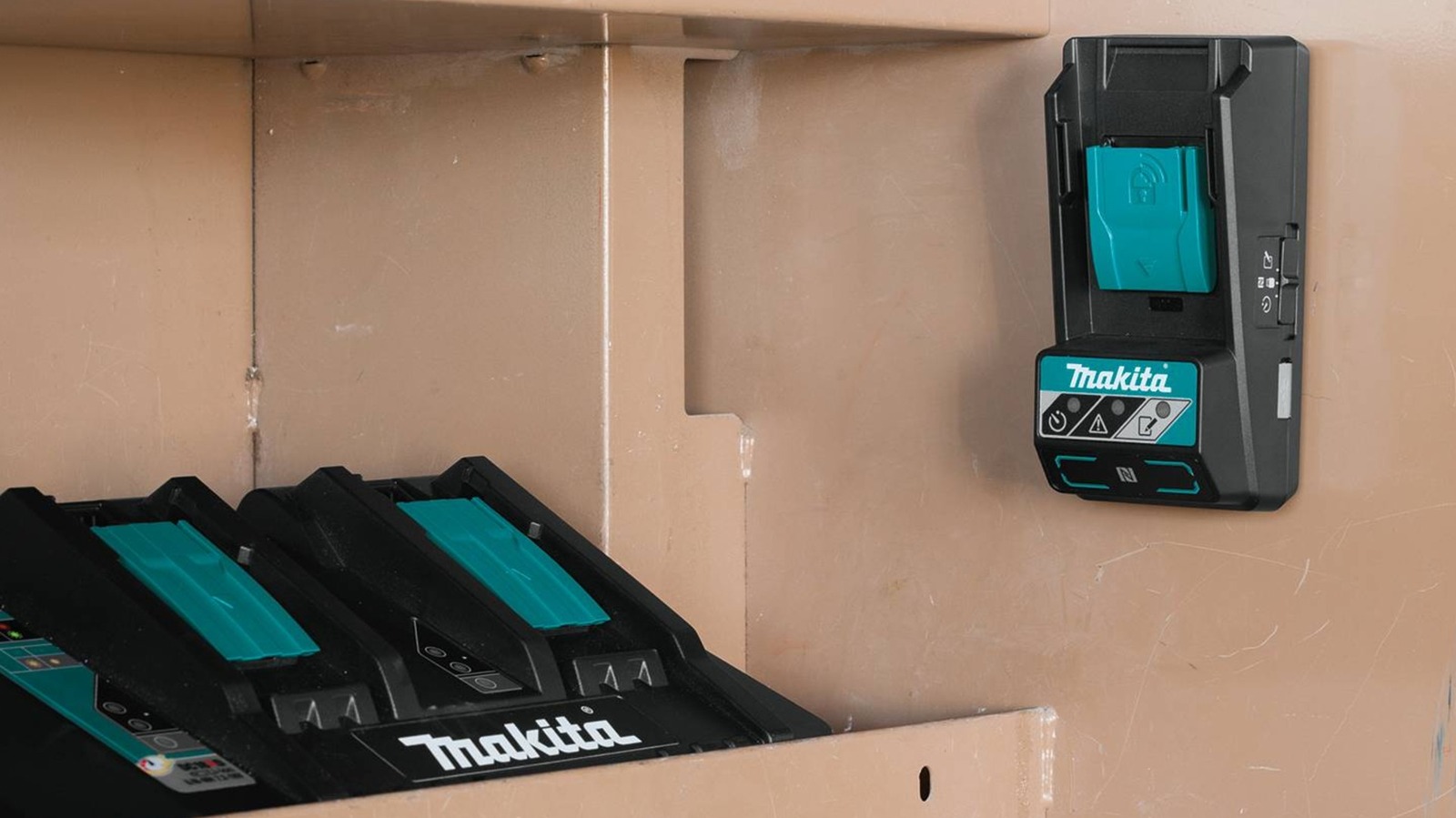Docker Management Is Evolving These 8 Tools Made My Life Easier
It’s 2025. Stop managing Docker like you’re still debugging in Bash loops. Introduction If you’ve ever spent your Saturday night fixing a broken docker-compose.yml stack instead of gaming, this one’s for you. Back in 2020, managing Docker felt like performing black magic. You’d build images that weighed more than your Steam library, containers crashed mid-demo, and every CI pipeline was a fragile house of cards waiting for one misplaced ENV line to crumble. But times have changed. It’s 2025. The DevOps landscape around Docker has matured faster than a speedrun leaderboard. We now have battle-tested tools that solve the problems we used to just “cope with” bloated images, flaky local dev loops, zero observability, and container graveyards on our systems. This article is not a “10 tips to optimize Docker” fluff piece. It’s a real dev’s survival kit tools I use daily that actually make container management feel smooth, even fun. Some are sleek GUIs, others are CLI power tools. A few you probably haven’t heard of. All of them changed the way I work with Docker. Ready to unchain yourself from the old ways? Let’s dive into the toolbelt. Section 2: Why 2020 Docker Workflows Suck in 2025 Ah yes, the good ol’ days of Docker in 2020: Running docker ps to check what’s broken (spoiler: everything) Manually restarting containers like it’s your side gig Pushing 1.2GB images to production with fingers crossed Forgetting to rebuild after a change and wondering why it’s not working Managing updates by… not managing them at all Look — Docker was (and still is) a solid tool. But the ecosystem around it was immature. Most of us duct-taped workflows using a mix of shell scripts, YAML sorcery, and frustration. Here’s what made those workflows painful: 1. Slow, Bloated Image Builds You’d layer package managers, install tools you didn’t need, and ship images with more junk than a 90s PC. Multi-stage builds existed, but no one used them right. 2. Zero Automation If you weren’t running Jenkins or GitHub Actions just right, updating a container meant SSH’ing into a server and pulling new images manually. Yes, like it’s 2013. 3. No Visibility Docker logs are useful — until they aren’t. Figuring out why something crashed was like hunting a bug in Narnia. Want metrics? Good luck setting up Prometheus just for a dev container. 4. Painful Dev Loops Rebuild. Restart. Realize you forgot to COPY . . in your Dockerfile. Rebuild again. That’s 20 minutes you’re not getting back. Multiply that by 5 containers and now it’s a day. 5. No Auto Updates, No Recovery One outdated container turns into two, then ten. You forget what’s running. Something breaks during deploy — and your only rollback plan is Ctrl+C and prayer. We tolerated all this because we had no choice. But now? There are better tools. Smoother. Smarter. And actually fun to use. Section 3: The 8 Tools That Actually Made Docker Fun Again These aren’t buzzwordy “alternatives” — these are legit, practical tools that made me stop dreading container work. I’ll walk you through each one, what problem it solves, and when it shines. 1. Dagger — The CI/CD Brain Docker Always Wanted What it is: Dagger lets you build CI/CD pipelines using containers as the engine — it treats infrastructure as code with a real programming model (using Go or Python). It’s like Docker meets Bazel, but way friendlier. How it works: You define “pipelines” in code that run inside containers. You can run them locally exactly as they would in CI. Say goodbye to “it works on CI but not on my machine” drama. When to use it: Complex CI/CD that involves multi-container builds Testing & deployment workflows with branching logic You want container reproducibility from dev to prod When not to use it: Super-simple pipelines (you’ll be overengineering) Teams with zero devops background — there’s a learning curve Real-world example: We replaced 700 lines of GitHub Actions YAML with a Dagger pipeline that built, tested, pushed, and deployed 3 services — all in one composable script. Bonus: It ran the same locally. 2. OrbStack — The Fastest Docker for Mac, Period What it is: OrbStack is a lightning-fast Docker + Linux VM for macOS that feels like WSL for Mac — lightweight, instant startup, and no more Docker Desktop drama. How it works: It runs containers and Linux distros natively with macOS integration. Think of it as Docker Desktop without the slowness or bloat. When to use it: You’re a Mac dev tired of Docker Desktop Need fast local dev environments Want better resource usage and networking When not to use it: You’re on Linux or Windows (it’s Mac-only) Your team relies on Docker Desktop features (like GUI settings) Real-world example: I replaced Docker Desktop with OrbStack. My container startup times dropped from 10 seconds to 1.5. And no more 3GB RAM usage just to keep it running. 3. Tilt — Instant Feedback for Docker-Based Dev What it is: Tilt is like hot reload for your containers. It watches y

It’s 2025. Stop managing Docker like you’re still debugging in Bash loops.
Introduction
If you’ve ever spent your Saturday night fixing a broken docker-compose.yml stack instead of gaming, this one’s for you.
Back in 2020, managing Docker felt like performing black magic. You’d build images that weighed more than your Steam library, containers crashed mid-demo, and every CI pipeline was a fragile house of cards waiting for one misplaced ENV line to crumble.
But times have changed.
It’s 2025. The DevOps landscape around Docker has matured faster than a speedrun leaderboard. We now have battle-tested tools that solve the problems we used to just “cope with” bloated images, flaky local dev loops, zero observability, and container graveyards on our systems.
This article is not a “10 tips to optimize Docker” fluff piece. It’s a real dev’s survival kit tools I use daily that actually make container management feel smooth, even fun. Some are sleek GUIs, others are CLI power tools. A few you probably haven’t heard of. All of them changed the way I work with Docker.
Ready to unchain yourself from the old ways? Let’s dive into the toolbelt.
Section 2: Why 2020 Docker Workflows Suck in 2025
Ah yes, the good ol’ days of Docker in 2020:
- Running
docker psto check what’s broken (spoiler: everything) - Manually restarting containers like it’s your side gig
- Pushing 1.2GB images to production with fingers crossed
- Forgetting to rebuild after a change and wondering why it’s not working
- Managing updates by… not managing them at all
Look — Docker was (and still is) a solid tool. But the ecosystem around it was immature. Most of us duct-taped workflows using a mix of shell scripts, YAML sorcery, and frustration.
Here’s what made those workflows painful:
1. Slow, Bloated Image Builds
You’d layer package managers, install tools you didn’t need, and ship images with more junk than a 90s PC. Multi-stage builds existed, but no one used them right.
2. Zero Automation
If you weren’t running Jenkins or GitHub Actions just right, updating a container meant SSH’ing into a server and pulling new images manually. Yes, like it’s 2013.
3. No Visibility
Docker logs are useful — until they aren’t. Figuring out why something crashed was like hunting a bug in Narnia. Want metrics? Good luck setting up Prometheus just for a dev container.
4. Painful Dev Loops
Rebuild. Restart. Realize you forgot to COPY . . in your Dockerfile. Rebuild again.
That’s 20 minutes you’re not getting back. Multiply that by 5 containers and now it’s a day.
5. No Auto Updates, No Recovery
One outdated container turns into two, then ten. You forget what’s running. Something breaks during deploy — and your only rollback plan is Ctrl+C and prayer.
We tolerated all this because we had no choice. But now? There are better tools. Smoother. Smarter. And actually fun to use.

Section 3: The 8 Tools That Actually Made Docker Fun Again
These aren’t buzzwordy “alternatives” — these are legit, practical tools that made me stop dreading container work. I’ll walk you through each one, what problem it solves, and when it shines.
1. Dagger — The CI/CD Brain Docker Always Wanted
What it is:
Dagger lets you build CI/CD pipelines using containers as the engine — it treats infrastructure as code with a real programming model (using Go or Python). It’s like Docker meets Bazel, but way friendlier.
How it works:
You define “pipelines” in code that run inside containers. You can run them locally exactly as they would in CI. Say goodbye to “it works on CI but not on my machine” drama.
When to use it:
- Complex CI/CD that involves multi-container builds
- Testing & deployment workflows with branching logic
- You want container reproducibility from dev to prod
When not to use it:
- Super-simple pipelines (you’ll be overengineering)
- Teams with zero devops background — there’s a learning curve
Real-world example:
We replaced 700 lines of GitHub Actions YAML with a Dagger pipeline that built, tested, pushed, and deployed 3 services — all in one composable script. Bonus: It ran the same locally.
2. OrbStack — The Fastest Docker for Mac, Period
What it is:
OrbStack is a lightning-fast Docker + Linux VM for macOS that feels like WSL for Mac — lightweight, instant startup, and no more Docker Desktop drama.
How it works:
It runs containers and Linux distros natively with macOS integration. Think of it as Docker Desktop without the slowness or bloat.
When to use it:
- You’re a Mac dev tired of Docker Desktop
- Need fast local dev environments
- Want better resource usage and networking
When not to use it:
- You’re on Linux or Windows (it’s Mac-only)
- Your team relies on Docker Desktop features (like GUI settings)
Real-world example:
I replaced Docker Desktop with OrbStack. My container startup times dropped from 10 seconds to 1.5. And no more 3GB RAM usage just to keep it running.
3. Tilt — Instant Feedback for Docker-Based Dev
What it is:
Tilt is like hot reload for your containers. It watches your code, rebuilds containers (or images), and redeploys your app automatically.
How it works:
You write a Tiltfile that tells Tilt how to run and reload your services. It supports Docker and Kubernetes, with UI + logs in real time.
When to use it:
- Microservices with tons of moving parts
- Kubernetes-based local dev
- You want to cut rebuild → run → debug loops
When not to use it:
- Single-container projects
- If you hate learning new syntax (Tiltfile is new-ish)
Real-world example:
Tilt helped our team of 4 devs reduce rebuild time from 2 minutes to ~10 seconds — each time someone made a code change. Massive productivity win.
4. Croc — Securely Share Docker Contexts or Files
What it is:
Croc lets you send files securely and easily between devices via CLI — like scp, but way cooler and safer.
How it works:
It sets up an encrypted tunnel using a relay, so you can share files (like Docker contexts, .tar images, .env files) with a single command:
croc send docker-context.tar.gz
When to use it:
- Pair programming or remote debugging
- Sharing build artifacts between devs
- You need quick secure handoffs (without Dropbox or email)
When not to use it:
- Cloud-first setups with shared volumes
- If you’ve got CI/CD doing all artifact management
Real-world example:
We use Croc during code pairing sessions to transfer built Docker contexts fast, encrypted, and no setup needed.
5. Podman — The Rootless Docker Alternative
What it is:
Podman is a drop-in Docker CLI replacement that runs containers rootlessly — no daemon, no socket binding, just containers.
How it works:
You run podman like docker, but it works without a daemon. You can also run systemd inside containers (super cool for services). It even supports pods like Kubernetes.
When to use it:
- You want secure containers in dev and prod
- You hate the Docker daemon crashing
- You’re into automation or rootless deployments
When not to use it:
- You’re deeply tied into Docker-only tooling
- GUI-based Docker management is a must
Real-world example:
We use Podman for CI containers on our Linux runner — no daemon, no root, less risk.
6. Lazydocker — A TUI That Makes Docker Human
What it is:
Lazydocker is a terminal UI for managing Docker containers, volumes, images, logs, and more — visually, from your CLI.
How it works:
Just run lazydocker and you get a curses-style interface. Scroll through containers, inspect logs, restart services, see CPU/mem usage.
When to use it:
- You’re tired of typing
docker logs100 times a day - You want quick insights into container health
- Local dev/debug sessions
When not to use it:
- Headless servers with no terminal access
- You need full-blown orchestration
Real-world example:
I use Lazydocker like a mission control dashboard for my dev stack — one pane, all the info I need.
7. Dive See Why Your Docker Image Is So Huge
What it is:
Dive lets you inspect and analyze each layer of a Docker image to see what’s bloating your builds.
How it works:
You run dive your-image and it shows you what each layer added — files, sizes, commands. You get a score too.
When to use it:
- You want smaller, faster Docker images
- Debugging CI time
- You’re optimizing for Fargate, Lambda, etc.
When not to use it:
- You don’t care about image size (aka you’re Google)
- One-off throwaway containers
Real-world example:
Cut a 700MB Node.js image down to 250MB using Dive — deleted unused global installs and layered smart.
8. Watchtower Keep Containers Updated. Automatically.
What it is:
Watchtower watches your running containers and updates them when a new image version is available.
How it works:
It checks your Docker registry, pulls the latest image, gracefully stops the old container, and spins up the new one — all automatically.
When to use it:
- Self-hosted apps that need to stay updated
- Teams without full CI/CD coverage
- Homelabs or one-man infra setups
When not to use it:
- Critical infrastructure that needs manual deploy control
- Canary/staged deploy setups
Real-world example:
Watchtower auto-updates our dev tools like Portainer, Postgres admin, and Redis UI — we never touch them again after setup.
Section 4: Tool Comparison Table
Because developers love charts almost as much as they hate writing tests.





























































































































































![[The AI Show Episode 143]: ChatGPT Revenue Surge, New AGI Timelines, Amazon’s AI Agent, Claude for Education, Model Context Protocol & LLMs Pass the Turing Test](https://www.marketingaiinstitute.com/hubfs/ep%20143%20cover.png)






























































































































![[FREE EBOOKS] AI and Business Rule Engines for Excel Power Users, Machine Learning Hero & Four More Best Selling Titles](https://www.javacodegeeks.com/wp-content/uploads/2012/12/jcg-logo.jpg)









































































































































































































































![Hostinger Horizons lets you effortlessly turn ideas into web apps without coding [10% off]](https://i0.wp.com/9to5mac.com/wp-content/uploads/sites/6/2025/04/IMG_1551.png?resize=1200%2C628&quality=82&strip=all&ssl=1)



![This new Google TV streaming dongle looks just like a Chromecast [Gallery]](https://i0.wp.com/9to5google.com/wp-content/uploads/sites/4/2025/04/thomson-cast-150-google-tv-1.jpg?resize=1200%2C628&quality=82&strip=all&ssl=1)













![Apple Drops New Immersive Adventure Episode for Vision Pro: 'Hill Climb' [Video]](https://www.iclarified.com/images/news/97133/97133/97133-640.jpg)

![Most iPhones Sold in the U.S. Will Be Made in India by 2026 [Report]](https://www.iclarified.com/images/news/97130/97130/97130-640.jpg)




































































































































